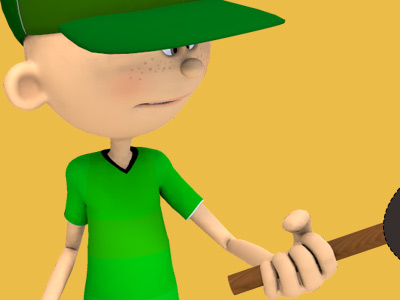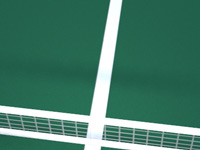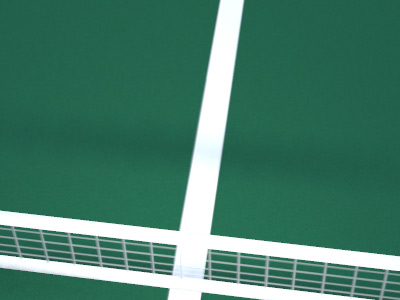Tennis

Court
A tennis court is the venue where the sport of tennis is played. It is a firm rectangular surface with a low net stretched across the center. The same surface can be used to play both doubles and singles matches. A variety of surfaces can be used to create a tennis court, each with its own characteristics which affect the playing style of the game.
Dimensions
Tennis is played on a rectangular flat surface, usually of grass, clay or hard material. The dimensions of a tennis court are defined and regulated by the International Tennis Federation (ITF) governing body and are written down in the annual 'Rules of Tennis' document. The court is 78 feet (23.77 metres) long. Its width is 27 feet (8.23 metres) for singles matches and 36 feet (10.97 metres) for doubles matches. The service line is 21 feet (6.40 metres) from the net. Additional clear space around the court is needed in order for players to reach overrun balls for a total of 60 feet (18 metres) wide and 120 feet (37 metres) long. A net is stretched across the full width of the court, parallel with the baselines, dividing it into two equal ends. The net is 3 feet 6 inches (1.07 metres) high at the posts, and 3 feet (0.91 metres) high in the center. The net posts are 3 feet (0.91 metres) outside the doubles court on each side or, for a singles net, 3 feet (0.91 metres) outside the singles court on each side.
Surfaces
Tennis is played on a variety of surfaces and each surface has its own characteristics which affect the playing style of the game. There are four main types of courts depending on the materials used for the court surface: clay courts, hard courts, grass courts and carpet courts. The International Tennis Federation (ITF) lists different surfaces and properties and classifies surfaces into one of five pace settings:
- Category 1 (slow)
- Category 2 (medium-slow)
- Category 3 (medium)
- Category 4 (medium-fast)
- Category 5 (fast)
Of the current Grand Slam tournaments, the US Open and Australian Open use hard courts, the French Open is played on clay, and Wimbledon is played on grass and is the only Grand Slam tournament to have always been played on one surface. The Australian Open switched to hard courts in 1988 and in its early years the French championship alternated between clay and sand/rubble courts. The US Open is the only one of the four majors to have been played on three surfaces; the tournament was played on grass from its inception until 1974, on green clay until 1977, and on hard courts since the tournament moved from the West Side Tennis Club to the National Tennis Center in 1978.
ITF uses the following classification for tennis court surface types:
| Surface code | Type | Description |
| A | Acrylic | Textured, pigmented, resin-bound coating |
| B | Artificial clay | Synthetic surface with the appearance of clay |
| C | Artificial grass | Synthetic surface with the appearance of natural grass |
| D | Asphalt | Bitumen-bound aggregate |
| E | Carpet | Textile or polymeric material supplied in rolls or sheets of finished product |
| F | Clay | Unbound mineral aggregate |
| G | Concrete | Cement-bound aggregate |
| H | Grass | Natural grass grown from seed |
| J | Other | E.g. modular systems (tiles), wood, canvas |
Clay court
A clay court is one of many different types of tennis court. Clay courts are made of crushed shale, stone or brick. The French Open uses clay courts, making it unique among the Grand Slam tournaments. Clay courts are more common in Continental Europe and Latin America than in the United States, Canada or Britain. Two types exist: red clay, the more common variety, and green clay, also known as "rubico", which is a harder surface. Although less expensive to construct than other types of tennis courts, the maintenance costs of clay are high as the surface must be rolled to preserve flatness. The water content must also be balanced; green courts are often sloped in order to allow water run-off.
Play
Clay courts favor the "full western grip" for more topspin. "Clay-courters" generally play in a semicircle about 1.5 to 3 metres (5 to 10 feet) behind the baseline. Clay courts are considered "slow", because the balls bounce relatively high and more slowly, making it more difficult for a player to deliver an unreturnable shot. Points are usually longer as there are fewer winners. Therefore, clay courts heavily favor baseliners who are consistent and have a strong defensive game, which has allowed players such as Rafael Nadal, Björn Borg, Chris Evert, and Justine Henin to find success at the French Open.
Clay court players use topspins to throw off their opponents. Movement on gravel courts is very different from movement on any other surface. Playing on clay often involves the ability to slide into the ball during the stroke, as opposed to running and stopping like on a hard or grass court. Players who excel on clay courts but struggle to replicate the same form on fast courts are known as clay-court specialists.
Clay courts are unique in that the ball bounce leaves an impression in the ground, which can help determine whether a shot was in or out. Critics of red clay courts point to the constant need to wet them down, problems renewing the surface if it dries out, and the damage caused to clothing and footwear through stains. All clay courts, not just red clay, tend to cause a build-up of clay on the bottom of the shoes of the players, needing constant removal.
Variants
Red clay
Almost all red "clay" courts are made not of natural clay but of crushed brick that is packed to make the court. The crushed brick is then covered with a topping of loose crushed particles. This type of surface does not absorb water easily and is the most common in Europe and Latin America. The French Open is played on red clay courts at Stade Roland Garros. True natural clay courts are rare because they take two to three days to dry. A good example of natural red clay can be seen at the Frick Park Clay Courts in Pittsburgh, a public facility of six red clay courts that has been in continual use since 1930.
A crushed brick surface was introduced by a British firm, En Tout Cas, in 1909, to address the drainage problem of the clay surface. En tout cas, also known as "fast-dry", or "continental clay", court surfaces spread through Europe in the 1920s. An en tout cas court plays similarly to natural clay despite its considerably more granular appearance. The crushed brick surface allowed more water to run through the surface of the court drying the surface more quickly after a rain. In France, Spain and Italy "fast-dry" surfaces were generally shallower, consisting of powdered brick or red sand, making these courts appear more like natural clay surfaces.
Green clay
Green clay, also called rubico and the brand name Har-Tru, is similar to red clay, but is made from crushed metabasalt rather than brick, making the surface slightly harder and faster. Green clay is packed to make the subsurface. It is then covered with a topping. These clay courts can be found in all 50 of the United States but are located primarily in the Eastern and Southern states.
Clay-court specialist
A clay-court specialist is a tennis player who excels on clay courts.
Due in part to advances in racquet technology, today's clay-court specialists are also known for employing long, winding groundstrokes that generate heavy topspin, strokes which are less effective when the surface is faster and the balls don't bounce as high. Clay-court specialists tend to slide more effectively on clay than other players. Many of them are also very adept at hitting the drop shot, which can be effective because rallies on clay courts often leave players pushed far beyond the baseline. Additionally, the slow, long rallies require a great degree of mental focus and physical stamina from the players.
Increasingly, clay courters have attempted to play better on other surfaces with some success. Ferrero reached the US Open Final in 2003, the same year he won the French Open, and has also won hardcourt tournaments. Nadal was considered a clay court specialist until a string of successes on other surfaces, including completing a career grand slam, led to a broadening of his reputation, while Muguruza reached the 2015 Wimbledon final the year before she won the French Open
Professional tournaments played on clay
The professional clay court season comprises many more tournaments than the brief grass court season, but is still shorter than the hard court seasons. There are three distinct clay court seasons during the year.
The first is the winter clay season in South America for men that occurs primarily in February after the Australian Open and before the Indian Wells Masters. The ATP has four tournaments in this swing, while the WTA discontinued its participation in Rio de Janeiro after 2016.
The second is the long spring clay season that starts in the Americas before moving to mainland Europe and Morocco leading up to the French Open. It is usually played over two months in April and May after the Miami Open concludes. Unlike the other two clay seasons, for the most part, this swing does not share the majority of its time with simultaneous hard court tournaments.
The third is the brief summer clay season that takes place after Wimbledon. It is entirely in Europe, and usually takes place in July. Near the end of the swing, it overlaps with the beginning of the US Open Series.
Grass court
A grass court is one of the four different types of tennis court on which the sport of tennis, originally known as "lawn tennis", is played. Grass courts are made of grasses in different compositions depending on the tournament.
Although grass courts are more traditional than other types of tennis courts, maintenance costs of grass courts are higher than those of hard courts and clay courts. Grass courts (in the absence of suitable covers) must be left for the day if rain appears, as the grass becomes very slippery when wet.
Grass courts are most common in Britain, although the Northeastern United States also has some private grass courts.
Play style
Because grass courts tend to be slippery, the ball often skids and bounces low while retaining most of its speed, rarely rising above knee height. In addition, there are often bad bounces. As a result, players must reach the ball faster relative to other surfaces, and rallies are likely to be comparatively brief; therefore, speed and power are rewarded on grass. On grass, the serve and return play a major part in determining the outcome of the point, increasing the importance of serving effectively, and maintaining focus in exchanges which can be heavily influenced by lapses in concentration. A grass-court favours a serve and volley style of play.
Professional tournaments played on grass
The professional grass court season is comparatively short. Until 2014 it consisted only of Wimbledon, two weeks of tournaments in Britain and continental Europe leading up to it, and the Hall of Fame Tennis Championships in the Newport, Rhode Island, United States the week after. In 2015 it was extended, with an extra week between the French Open and Wimbledon. In the ATP Tour, the Stuttgart Open became a grass court tournament in 2015, and in 2017 a new ATP 250 tournament is being hosted in Antalya (Turkey), a week before Wimbledon. In the WTA Tour Mallorca will host a grass court tournament beginning in 2016.
Hardcourt
A hardcourt (or hard court) is a surface or floor on which a sport is played, most usually in reference to tennis courts. They are typically made of rigid materials such as asphalt or concrete, and covered with acrylic material to seal the surface and mark the playing lines, while providing some cushioning. Historically, hardwood surfaces were also in use in indoor settings, similar to an indoor basketball court, but these are now rare.
Tennis hard courts are made of synthetic/acrylic layers on top of a concrete or asphalt foundation and can vary in color. These courts tend to play medium-fast to fast because there is little energy absorption by the court, like in grass courts. The ball tends to bounce high and players are able to apply many types of spin during play. Flat balls are favored on hard courts because of the extremely quick play style. Speed of rebound after tennis balls bounce on hard courts is determined by how much sand is in the synthetic/acrylic layer placed on top of the asphalt foundation. More sand will result in a slower bounce due to more friction.
Of the Grand Slam tournaments, the US Open and Australian Open currently use hard courts and it is the predominant surface type used on the professional tour.
Maintenance
There are numerous hardcourt maintenance methods which are commonly used to keep these facilities in top condition. Some of these include brushing, pressure washing with a cleaning solution and applying chemical treatments to prevent the growth of moss and algae. Anti-slip paint is also applied to hardcourts to give better playing qualities which enhance play.
Carpet court
A carpet court is a type of tennis court. The International Tennis Federation defines carpet courts as a "textile surface of woven or non-woven nylon, or a polymeric or rubber material, typically supplied in rolls or sheets" and as a removable surface. It is one of the fastest court types second only to grass courts. The use of carpet courts in professional competitions ended in 2009 to unify the surfaces used within ATP tour matches and to reduce injuries.
Types
There are two types of carpet court. The most common outdoor version consists of artificial turf infilled with sand. This type of carpet court became popular in the 1980s in British and Asian tennis clubs for recreational play as they were easier and cheaper to maintain than grass courts. The other type used predominantly for indoor tennis is a textile surface of nylon or rubber matting laid out on a concrete base. These have been used in venues which are not normally used for tennis or other sports, such as the Royal Albert Hall in London. Playing on carpet courts, players usually approach it as they would a grass court due to both being similarly fast surfaces.
Professional tournaments
In years past, professional tournaments used carpet courts. The WCT Finals, U.S. Pro Indoor, Antwerp Open, Kremlin Cup, Paris Masters and Zagreb Indoors tournaments were all once played on carpet. In 2009, the ATP and WTA decided to end the use of carpet courts in professional tournaments as part of a drive to standardise competitions to hard courts as well as to prevent injuries to players. A number of players including Mario Ančić and Jo-Wilfried Tsonga criticised the move stating that professional tennis needed carpet courts for players to develop their ability for playing on fast courts and that having four surfaces created variety for spectators.
Terminology
Common tennis court terms:
- Advantage service box or ad court: The receiver's left side service box, or the opponent's right for the server; significant as the receiving side for an advantage point.
- Alley or Tramlines: The lanes on each side of the singles court. These are only used when playing doubles.
- Back court: The area between the baseline and the service line.
- Baseline: The rearmost line of the court, furthest from and parallel to the net.
- Center service line: The line dividing the two service boxes on each side.
- Center mark: The 12-inch mark at the halfway point of the baseline used to distinguish the two halves (and service boxes) of a tennis court.
- Deuce service box or deuce court: The receiver's right side service box, or the opponent's left for the server, significant as the receiving side for a deuce point.
- Service box: The area on each side bounded by the singles sideline, the service line, and the net. There are left and right service boxes, separated by the center service line.
- Service line: The line that is parallel to the net and is located between the baseline and the net. It marks the end of the service boxes.
- Side T: The T shape formed by the service line and the singles sideline. There are four such side Ts, two on each side of the net.
- T or Middle T: The T shape formed by the service line and the center service line.
SPORTS

RESOURCES
This article uses material from the Wikipedia articles "Tennis", "Court", "Clay court", "Grass court", "Hardcourt", "Carpet court", which is released under the Creative Commons Attribution-Share-Alike License 3.0.
© Stories Preschool. All Rights Reserved.









